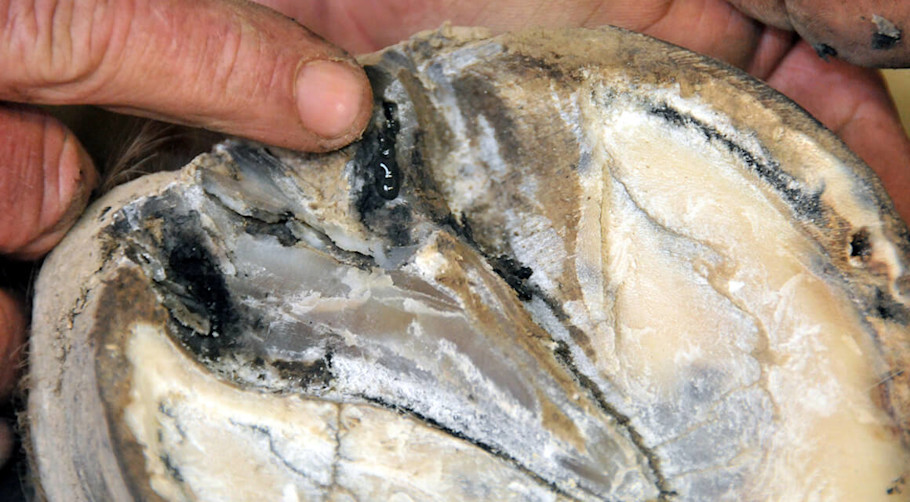Thrush in Horses – Farrier Tips for Treatment & Prevention
Updated October 18, 2024

What is Thrush?
Thrush is an infection of the frog of the horse’s hoof causing a thick, black, foul-smelling discharge. The infection usually occurs in the grooves on either side of the frog (collateral sulci) and/or the central sulcus (in the middle of the frog). There are several bacteria and fungi thought to be involved in thrush, including Fusobacterium necrophorum.
You can spot thrush by its signature stinky odor and oily ooze when picking out your horse’s hoof. Your horse may also be showing signs of pain or sensitivity to the hoof or leg.
It’s one of the most common conditions of the hoof as this dark, unoxygenated, and non-vascular area can become a breeding ground for bacteria. Learning the causes, treatments, and ways to prevent thrush from becoming a chronic issue is key to your horse’s health from the hoof up.
Video on the Signs and Remedies for Thrush
This video features SmartPak Hoof Health Consultant Danvers Child, CJF, who describes the potential signs and treatment options for thrush in horses.
Causes of Thrush in Horse Hooves
The design of the horse’s hoof provides a natural cleaning mechanism that should keep thrush and other hoof conditions at bay. Factors that can restrict the hoof’s ability to self-clean and potentially cause a bacterial infection include:
- Abnormal hoof shape – deep, narrow grooves (sulci) on either side of the frog are built-in traps for dirt and moisture and do not have much exposure to air—conditions thrush-causing microorganisms thrive in.
- Chronic lameness and/or poor circulation in the foot.
- Improper trimming or hoof care.
- Insufficient exercise or too much stall time.
- Poor diet.
Busting Myths About Thrush
Once thought to be caused by a wet and dirty environment, experts now believe certain factors contribute to the development of thrush even in the cleanest situations. Meaning, thrush occurs in horses that live outside AND those kept in the most pristine stables.
Treatment of Thrush

- The infected hoof should be picked, cleaned, and medicated as recommended by the veterinarian or farrier.
- The hoof should be balanced as much as possible.
- The horse should be turned out as well as worked.
- Any causes of chronic lameness should be treated.
There are several thrush treatment products available, however, unless the underlying cause is diagnosed and corrected, thrush will return. That’s because thrush isn’t so much a problem of a dirty environment attacking a horse’s hoof as it is a problem of a horse’s hoof not being healthy enough to resist infection.
Your farrier or veterinarian may recommend a homemade recipe treatment that contains ingredients such as iodine, vinegar, or hydrogen peroxide. Some may also use poultices or hoof packing as drawing agents for the infection.
Do not use any caustic substances, like bleach or formalin, as these will do harm to the sensitive structures of your horse’s hooves.
Treatment for Serious Cases of Thrush
If these organisms invade deep enough and infect living, sensitive tissues, the horse may become lame from the condition (although this is rare). The frog may recess and lose its integrity, and fissures or deep pockets may develop and extend to the heels or hairline.
In severe cases of thrush, the veterinarian and farrier may need to work together to perform more extensive cleaning that involves removing dead and infected tissue before healing can begin. In this situation, it is even more important that the primary reason for thrush be identified and treated.
How to Approach Chronic Cases of Thrush
Recurring cases of thrush in one or several of your horse’s hooves will require the attention of your veterinarian, farrier, or hoof health professional. Work closely with them to diagnose why your horse’s one hoof is prone to thrush, and together you’ll be able to come up with a plan to correct the underlying issue.
It may take the better part of a year to grow a healthy well-shaped, balanced hoof, but the results will be worth it: no more thrush and no more daily medicating!
Video on Why Horses May Seem to be Prone to Thrush
How to Prevent Thrush
Preventing thrush starts with proper, regular, and professional hoof care to ensure your horse’s hooves are balanced and well-supported. A balanced hoof helps the horse maintain proper load distribution and promotes circulation.
Allowing your horse to have daily exercise - whether it be hand walking, lungeing, undersaddle work, or pasture time – is crucial to promoting vascularity in the hoof and overall health. Stall-bound horses are more prone to developing thrush because of the lack of movement and stimulation to the hoof.
Ensure your horse is kept in a clean, dry environment with stall cleaning to remove wet spots and manure. Be proactive in picking out your horse’s feet every day to remove dirt, rocks, manure, and debris and use the pick’s brush to clean out the sulci of the feet.